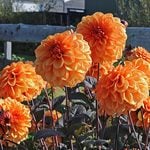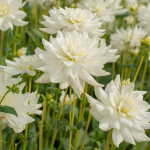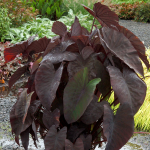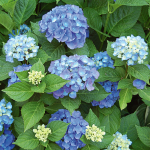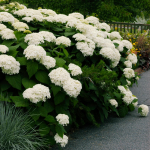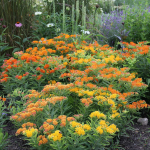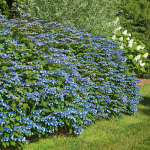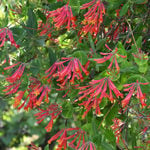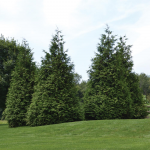Product Details
Vivid, 5–6″ purple-pink blooms grace plants with dark greenish purple leaves and stems. Dahlia 'Engelhardt's Matador' provides a spectacular display when paired with pinks and deep purples in the perennial border.
The Dahlia genus is made up of tuberous plants native to Mexico and Central America, celebrated for their wide range of colors, sizes, and flower forms, making them a favorite among gardeners and florists alike. With thousands of cultivars, Dahlias offer an incredible variety for any garden design, from small border plants to striking dinner plate-sized blooms, showcasing their versatility and ornamental appeal. They bloom from midsummer through fall, providing vibrant displays. Dahlias prefer full sun (though partial shade is acceptable), well-drained soil, and even moisture. They are perennial in Zones 8–10. In colder zones they are treated as annuals and need to be overwintered indoors. Through years of growing and trialing, we've selected some of the best performers to offer to our customers.
Please note: Dahlias should be planted outside once the danger of frost has passed and soil temperature has reached approximately 60°F. We ship Dahlia tubers beginning in early spring. The tubers may be stored in their bags in a cool, dark, dry spot until warmer weather arrives (the bottom of a closet in a cool room or a box in the basement work nicely; do not refrigerate), or they may be prepotted indoors to start them growing before they are transplanted into the garden.
For more information on growing Dahlias, click Growing Guide.
Shipping
HOW PLANTS ARE SHIPPED
The size of the plants we ship has been selected to reduce the shock of transplanting. For some, this means a large, bareroot crown. Others cannot travel bareroot or transplant best if grown in containers. We ship these perennials and annuals in 1 pint pots, except as noted. We must point out that many perennials will not bloom the first year after planting, but will the following year, amply rewarding your patience. We ship bulbs as dormant, bare bulbs, sometimes with some wood shavings or moss. Shrubs, Roses, vines, and other woody plants may be shipped bareroot or in pots. The size of the pot is noted in the quick facts for each item.
WHEN WE SHIP
We ship our bulbs and plants at the right time for planting in your area, except as noted, with orders dispatched on a first-come, first-served basis by climate zone. We also ship a wide range of containers and planters, tools, supplies, fertilizers, garden wear, garden decor items, as well as indoor decorations like wreaths and dried bouquets when available. Estimated dates for shipping are indicated in the green Shipping Details box for each item. Please supply a street address for delivery. Kindly contact us with two weeks notice, if you'll be away at the expected time of delivery.
OUR GUARANTEE
We guarantee to ship plants that are in prime condition for growing. If your order is damaged or fails to meet your expectations, we will cheerfully replace or refund it. Please contact our Customer Service Department at 1-800-503-9624 or email us at [email protected]. Please include your order number or customer number when contacting us.
Reviews
Average Customer Rating:
 (6 Reviews)
Write a Review
(6 Reviews)
Write a Review
Sort by:
Gorgeous 
A viewer from MA
1 of 1 people found this review helpful. Do you? yes no Certified buyer
I can't believe the red! 
CS from Wisconsin
2 of 2 people found this review helpful. Do you? yes no Certified buyer
Fabulous! 
A viewer from NW NJ
7 of 7 people found this review helpful. Do you? yes no Certified buyer
The Most Beautiful Flower 
A viewer from Southington, Ohio
14 of 14 people found this review helpful. Do you? yes no Certified buyer
Growing guide
Latin Name Pronunciation: dah'lee-uh
The Dahlia genus is made up of tuberous plants native to Mexico and Central America, celebrated for their wide range of colors, sizes, and flower forms, making them a favorite among gardeners and florists alike. With thousands of cultivars, Dahlias offer an incredible variety for any garden design, from small border plants to striking dinner plate-sized blooms, showcasing their versatility and ornamental appeal. They bloom from midsummer through fall, providing vibrant displays. Dahlias prefer full sun (though partial shade is acceptable), well-drained soil, and even moisture. They are perennial in Zones 8–10. In colder zones they are treated as annuals and need to be overwintered indoors. Through years of growing and trialing, we've selected some of the best performers to offer to our customers.
Please note: Dahlias should be planted outside once the danger of frost has passed and soil temperature has reached approximately 60°F. We ship Dahlia tubers beginning in early spring. The tubers may be stored in their bags in a cool, dark, dry spot until warmer weather arrives (the bottom of a closet in a cool room or a box in the basement work nicely; do not refrigerate), or they may be prepotted indoors to start them growing before they are transplanted into the garden.
Dahlia Care
Planting
For a single tuber or a tuber clump: Dig a hole about 4-6" deep and wide enough to accommodate the tuber. Place the tuber in the hole with the cut stem end and/or "eyes" at the top. (If you’re not certain which side is “up,” lay the tuber on its side.) Back-fill the hole gently, covering the tuber completely with 2-3" inches of soil. To avoid causing rot, do not water the tuber immediately after planting, unless the soil is very dry.Light/Watering
- Dahlias are at their best when grown in full sun in the North, and afternoon shade in the South.
- Do not water until growth appears above the ground; once plants are established, a deep watering twice a week will get them through summer dry periods.
Fertilizer/Soil and pH
- Soil temperature at planting should be 60°F.
- Dahlias prefer well-drained soil with a pH of 6.5 to 7.0.
- A fertilizer low in nitrogen is best (5-10-10, for example), first applied 30 days after planting and then monthly. Do not overfeed, and avoid high-nitrogen products.
Pests/Diseases
- Apply Sluggo® Plus, an effective, OMRI-listed organic control to prevent slugs from damaging Dahlia stems and new foliage.
- Earwigs can damage Dahlia buds, flowers and foliage. Keep the growing area around Dahlias clean of past foliage and flowers to minimize hiding areas for earwigs.
- Aphids can be controlled by spraying with insecticidal soap or Neem.
- If Dahlia stems show breakage and wilting, borers may be present; to deter, keep weeds away from the planting, and cut off and destroy any larvae-infested stems.
- If leafhoppers are a problem, spray plants with a mix of one tablespoon isopropyl alcohol to one pint of insecticidal soap, repeating 3 times at 3-to-5-day intervals.
- Watch for spider mites during hot, dry weather; spray leaves with Neem or a forceful jet of cold water, particularly on the undersides.
- If powdery mildew appears as a whitish coating on the leaves, spray with appropriate fungicide. Next year, give plants more space for better air circulation.
- If stems rot at the soil line or plants suddenly wilt and die, a bacterial or fungal agent may be present. Remove and destroy any affected plant parts; avoid this problem by planting in well-drained, light soil and do not overwater. Keep mulch several inches away from the plant stems.
Companion Plants
Dahlias can hold their own among:
Pruning
- Dahlias make excellent cut flowers; to achieve nice stems for cutting and bushier, compact plants, pinch out the center shoot just above the third set of leaves in late spring.
- To get the most out of your cut flowers, place them in very hot water (160°F) until it cools.
Reflowering
- If dead flowers are diligently removed, flowering will continue until the first hard frost.
- To develop large, exhibition-size blooms, remove side buds and allow only one bud per stem to develop.
Harvesting/Dividing
- Wait a few days after the foliage is blackened by frost before gently digging out the tubers to store for the winter
- Cut the stalk to 4–6″ tall, rinse the soil off the tubers, and allow the clump to air dry under cover for 24 hours.
- After harvesting, Dahlia tubers can be stored as a clump or divided and stored individually.
- If stored as a clump, you may divide them in the spring before planting. The eyes will be more visible but the tuber will be harder to cut.
- Use a sharp knife to cut the tubers apart, and try to cut so that each tuber or clump you segregate has at least one eye (a dormant bud). Only tubers with an eye will grow stems.
- Not all tubers will have visible eyes, so cutting a clump into halves or quarters is safer than separating a clump into all individual tubers.
- Line cardboard boxes or terracotta pots with newspaper and nest the tubers inside, covering them with barely moist sawdust, sand, or peat.
- If you are storing more than one Dahlia variety, label each tuber. (You may do this by writing with a Sharpie pen directly on the tuber, placing a tag on the tuber, or writing on the packing material or box.)
- Keep boxes cool (40–50°F) and dry for the winter in a dark spot
- Check for rot or shriveling on a monthly basis. If shriveling occurs, mist the packing material lightly with water. (Do not directly spray the tubers, and do not over-mist packing material as this can promote mold and fungus growth. As springtime nears, some tubers may develop eyes or begin sprouting leaves, others may not. Both developments are entirely normal.)
Calendar of Care
Early Spring
- When your tubers arrive in early spring, you may start them indoors in pots or keep them indoors in a cool, dark, dry place (a spot in the basement or the bottom of a closet in a cool room work nicely) then plant them out when the ground warms to 60 degrees F.
- Water tubers sparingly once after planting and then do not water again until new growth appears.
- Fertilize with 5-10-10 when growth reaches 2″ tall.
Mid-Spring
- Continue feeding every month.
- Watch for aphids and other insect pests and treat accordingly.
- Keep weeds away from plantings.
Late Spring
- Mulch if desired but keep material away from crowns and stems.
- Water thoroughly if season is dry.
- Tie larger varieties to stakes as they grow.
- Pinch out center shoots just above the third set of leaves, to allow branching
Summer
- Watch for signs of fungal wilt and remove and destroy affected plant parts if it occurs, then sterilize pruners with bleach solution.
- Monitor plants for aphids and other insect pests and treat accordingly.
- Continue to water if conditions indicate, and deadhead diligently for continuous bloom.
Fall
- Mulch plants heavily if overwintered in the ground in Zones 7 and above.
- Further north, wait until a few days after hard frost has killed the foliage, then dig tubers, and let them air dry under cover for 24 hours. Store them in newspaper-lined cardboard boxes or clay pots filled with lightly moistened sand, peat, or sawdust. Keep the boxes in a cool, dry and dark area of the basement or other interior space that is ideally around 40–50°F. Tubers may be divided before storing, if desired. If you have more than one variety, label each tuber.
- Remove and compost or discard all old foliage from the garden area.

